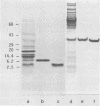Abstract
Extracts of granules of bovine neutrophils are known to exhibit a marked antibacterial activity in vitro. By a simple, two-step chromatographic procedure, we have resolved two peptide components of the antibacterial system. They were named Bac-5 and Bac-7 from the general term bactenecin and had molecular masses of about 5 and 7 kilodaltons, respectively. Over 45 and 20% of the amino acid residues in the two bactenecins are proline and arginine, respectively. The remaining amino acids are mainly hydrophobic (isoleucine, leucine, and phenylalanine). Both Bac-5 and Bac-7 efficiently kill Escherichia coli, Salmonella typhimurium, and Klebsiella pneumoniae. They also arrest the growth of Enterobacter cloacae (MICs, 25 to 200 micrograms/ml) but not of Proteus vulgaris, Staphylococcus aureus, and Streptococcus agalactiae (MIC, greater than 200 micrograms/ml). Finally, Bac-7 but not Bac-5 has MICs of less than or equal to 200 micrograms/ml for Pseudomonas aeruginosa and Staphylococcus epidermidis. From the comparison between the efficient bactericidal concentrations in vitro and the estimated content of bactenecins in neutrophils (125 ng of Bac-5 and Bac-7 each per 10(6) cells), it is reasonable to conclude that the two cationic peptides may exert a major role in host defense against at least some microorganisms.
Full text
PDF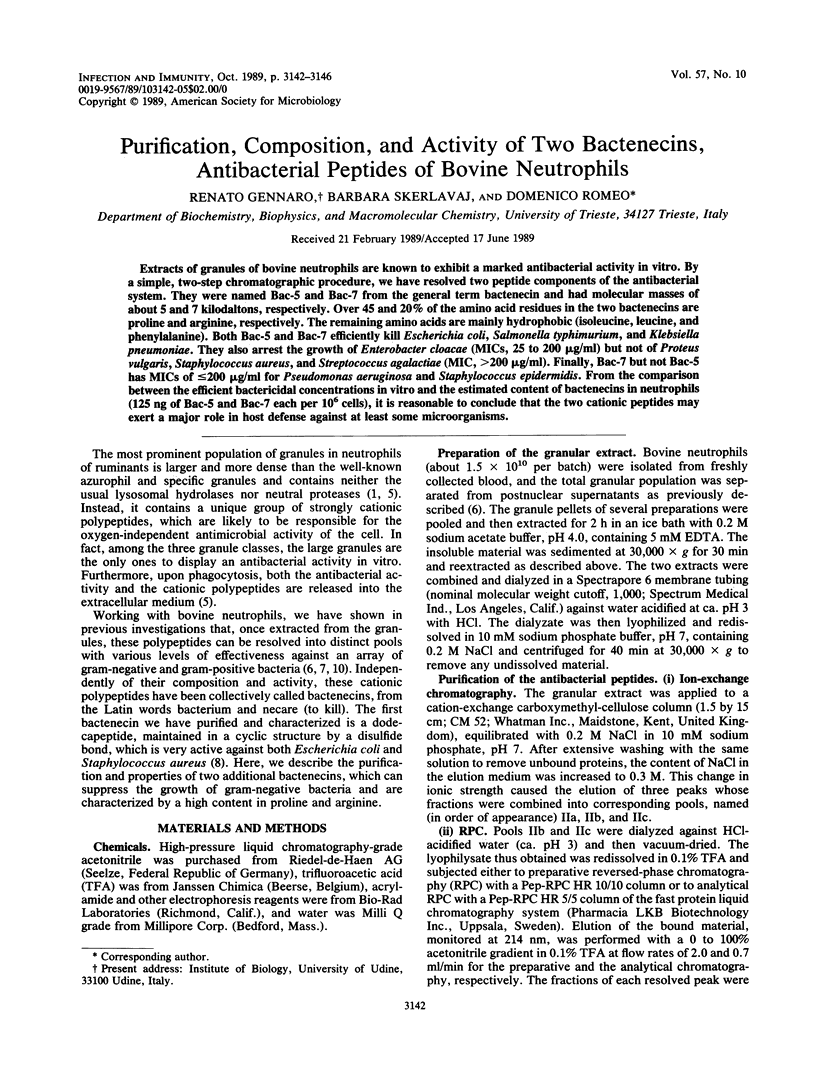
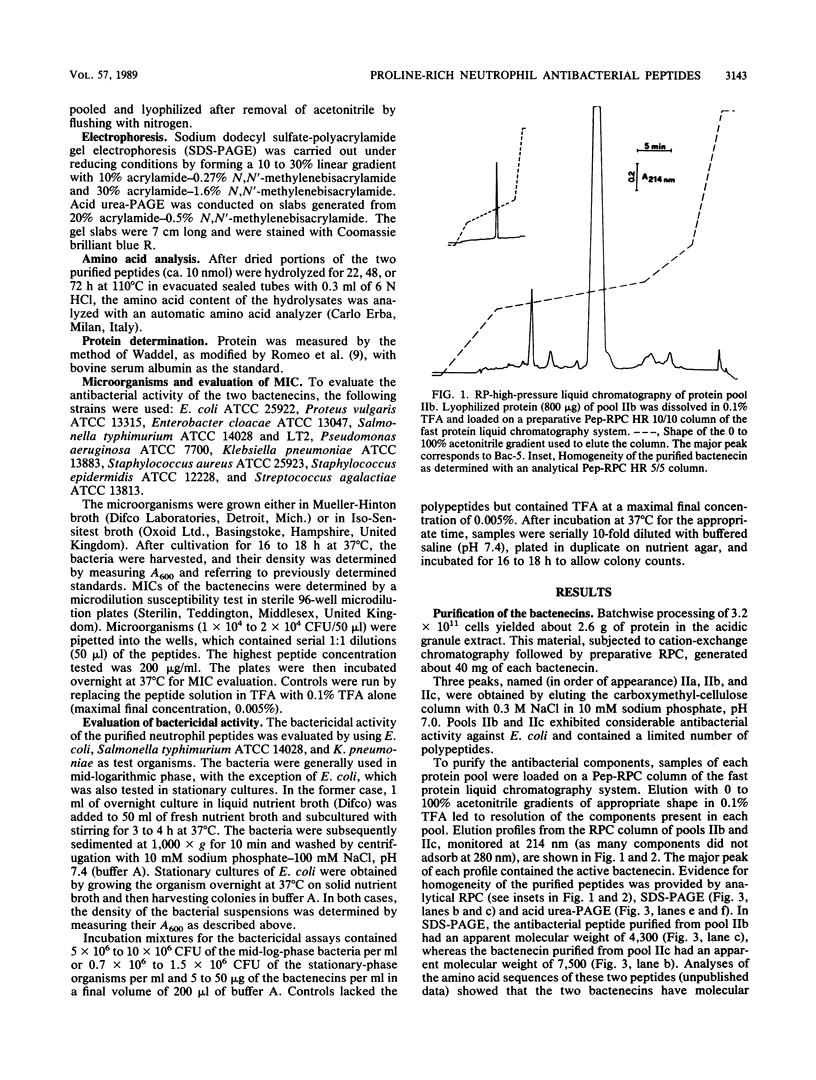
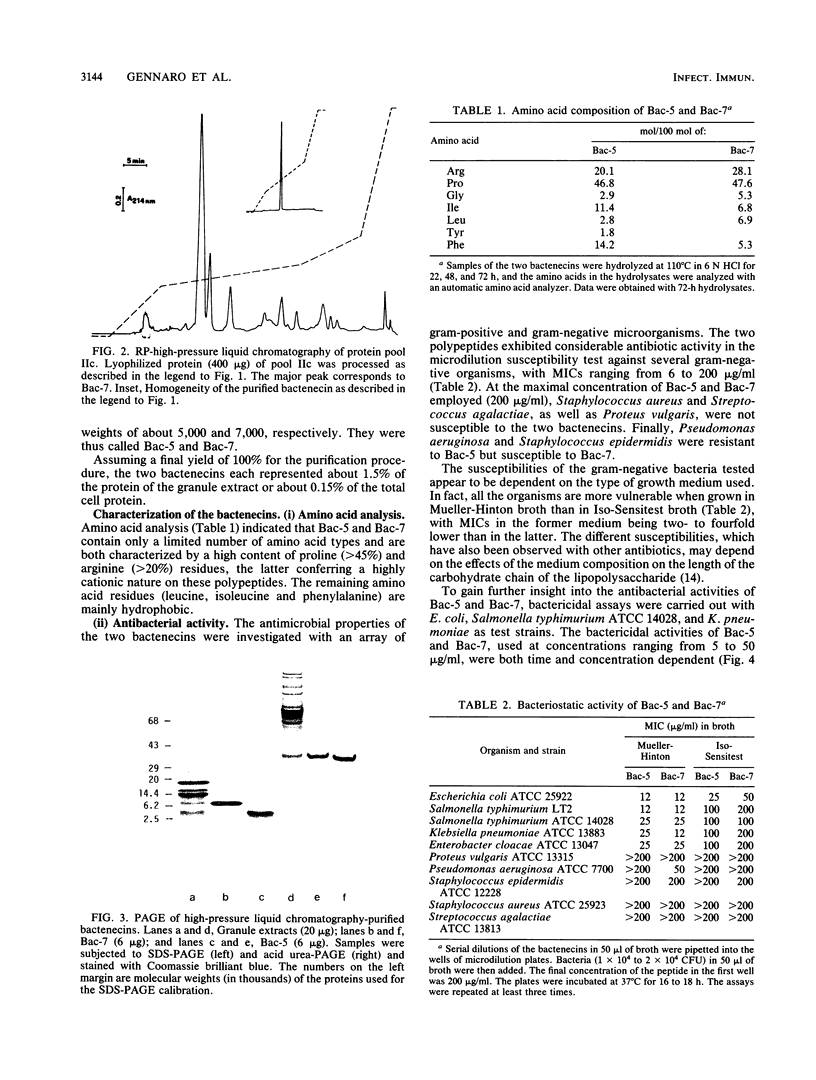
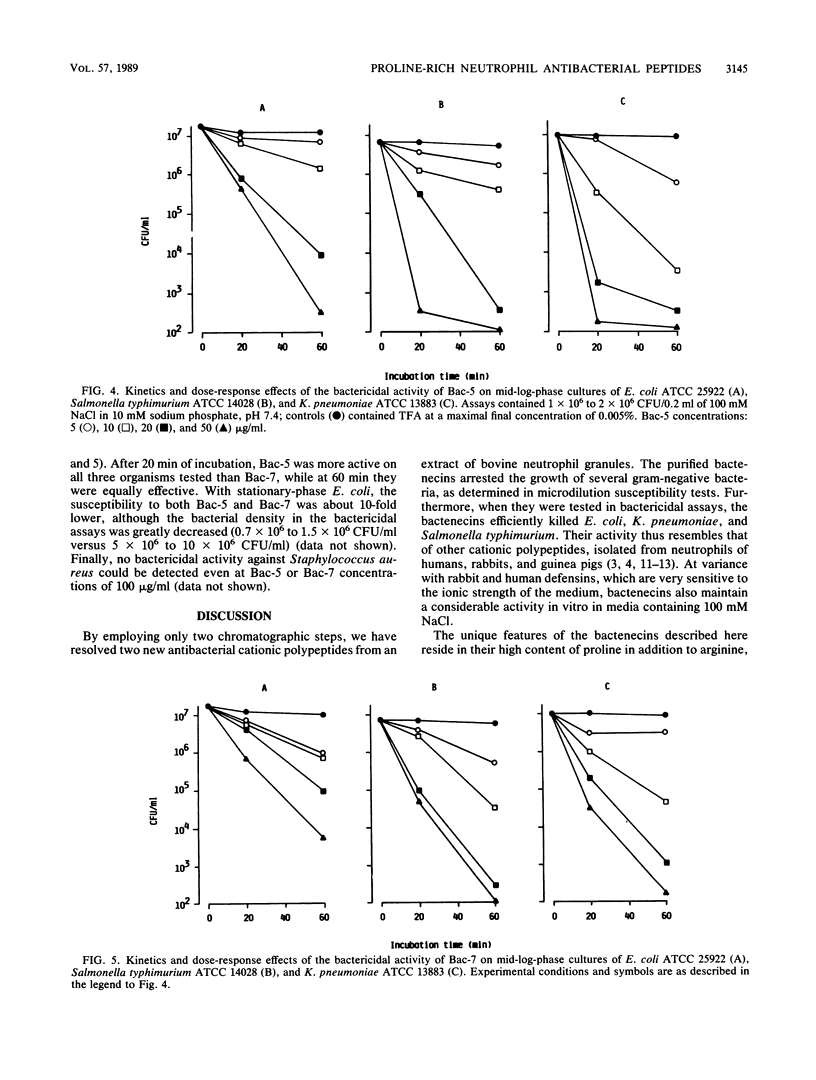
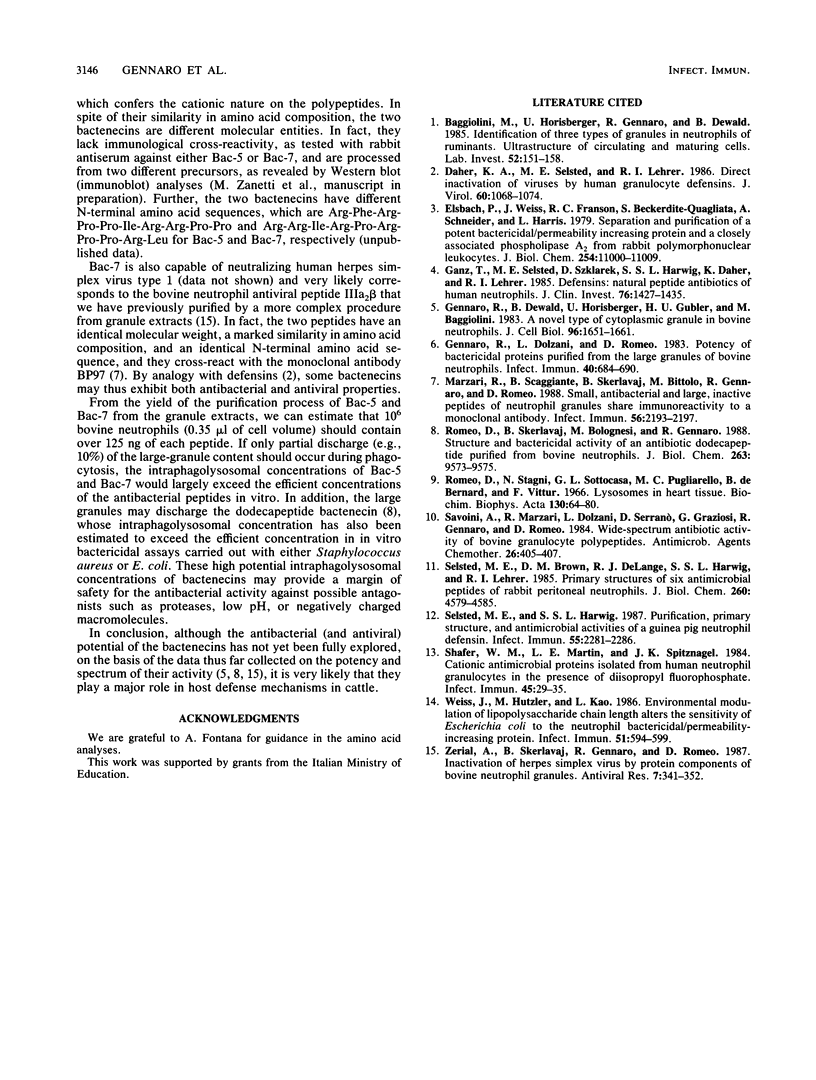
Images in this article
Selected References
These references are in PubMed. This may not be the complete list of references from this article.
- Baggiolini M., Horisberger U., Gennaro R., Dewald B. Identification of three types of granules in neutrophils of ruminants. Ultrastructure of circulating and maturing cells. Lab Invest. 1985 Feb;52(2):151–158. [PubMed] [Google Scholar]
- Daher K. A., Selsted M. E., Lehrer R. I. Direct inactivation of viruses by human granulocyte defensins. J Virol. 1986 Dec;60(3):1068–1074. doi: 10.1128/jvi.60.3.1068-1074.1986. [DOI] [PMC free article] [PubMed] [Google Scholar]
- Elsbach P., Weiss J., Franson R. C., Beckerdite-Quagliata S., Schneider A., Harris L. Separation and purification of a potent bactericidal/permeability-increasing protein and a closely associated phospholipase A2 from rabbit polymorphonuclear leukocytes. Observations on their relationship. J Biol Chem. 1979 Nov 10;254(21):11000–11009. [PubMed] [Google Scholar]
- Ganz T., Selsted M. E., Szklarek D., Harwig S. S., Daher K., Bainton D. F., Lehrer R. I. Defensins. Natural peptide antibiotics of human neutrophils. J Clin Invest. 1985 Oct;76(4):1427–1435. doi: 10.1172/JCI112120. [DOI] [PMC free article] [PubMed] [Google Scholar]
- Gennaro R., Dewald B., Horisberger U., Gubler H. U., Baggiolini M. A novel type of cytoplasmic granule in bovine neutrophils. J Cell Biol. 1983 Jun;96(6):1651–1661. doi: 10.1083/jcb.96.6.1651. [DOI] [PMC free article] [PubMed] [Google Scholar]
- Gennaro R., Dolzani L., Romeo D. Potency of bactericidal proteins purified from the large granules of bovine neutrophils. Infect Immun. 1983 May;40(2):684–690. doi: 10.1128/iai.40.2.684-690.1983. [DOI] [PMC free article] [PubMed] [Google Scholar]
- Marzari R., Scaggiante B., Skerlavaj B., Bittolo M., Gennaro R., Romeo D. Small, antibacterial and large, inactive peptides of neutrophil granules share immunoreactivity to a monoclonal antibody. Infect Immun. 1988 Aug;56(8):2193–2197. doi: 10.1128/iai.56.8.2193-2197.1988. [DOI] [PMC free article] [PubMed] [Google Scholar]
- Romeo D., Skerlavaj B., Bolognesi M., Gennaro R. Structure and bactericidal activity of an antibiotic dodecapeptide purified from bovine neutrophils. J Biol Chem. 1988 Jul 15;263(20):9573–9575. [PubMed] [Google Scholar]
- Savoini A., Marzari R., Dolzani L., Serranò D., Graziosi G., Gennaro R., Romeo D. Wide-spectrum antibiotic activity of bovine granulocyte polypeptides. Antimicrob Agents Chemother. 1984 Sep;26(3):405–407. doi: 10.1128/aac.26.3.405. [DOI] [PMC free article] [PubMed] [Google Scholar]
- Selsted M. E., Brown D. M., DeLange R. J., Harwig S. S., Lehrer R. I. Primary structures of six antimicrobial peptides of rabbit peritoneal neutrophils. J Biol Chem. 1985 Apr 25;260(8):4579–4584. [PubMed] [Google Scholar]
- Selsted M. E., Harwig S. S. Purification, primary structure, and antimicrobial activities of a guinea pig neutrophil defensin. Infect Immun. 1987 Sep;55(9):2281–2286. doi: 10.1128/iai.55.9.2281-2286.1987. [DOI] [PMC free article] [PubMed] [Google Scholar]
- Shafer W. M., Martin L. E., Spitznagel J. K. Cationic antimicrobial proteins isolated from human neutrophil granulocytes in the presence of diisopropyl fluorophosphate. Infect Immun. 1984 Jul;45(1):29–35. doi: 10.1128/iai.45.1.29-35.1984. [DOI] [PMC free article] [PubMed] [Google Scholar]
- Weiss J., Hutzler M., Kao L. Environmental modulation of lipopolysaccharide chain length alters the sensitivity of Escherichia coli to the neutrophil bactericidal/permeability-increasing protein. Infect Immun. 1986 Feb;51(2):594–599. doi: 10.1128/iai.51.2.594-599.1986. [DOI] [PMC free article] [PubMed] [Google Scholar]
- Zerial A., Skerlavaj B., Gennaro R., Romeo D. Inactivation of herpes simplex virus by protein components of bovine neutrophil granules. Antiviral Res. 1987 Jul;7(6):341–352. doi: 10.1016/0166-3542(87)90016-7. [DOI] [PubMed] [Google Scholar]



